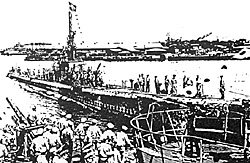3. RADAR A surface-search radar, SJ, was installed in 1942. Sketch below left is an early SJ set-up; and below right is the late war SJ. It was used to detect targets, find their range and bearing, and track them long enough to determine their course and speed. This also provided range and bearing to the Torpedo Data Computer. The Plan Position Indicator (PPI), a display showing the radar beam sweeping around a circle, was introduced later, followed shortly by radar intercept and countermeasure sets. Then came search radar and radar detectors to warn of enemy aircraft equipped with radar.
To solve the underwater torpedo fire control problem, a small radar antenna was installed in the periscope to obtain accurate firing ranges while exposing only a few feet of periscope. This new equipment was the ST and became operational in late 1944.
4. ACOUSTIC COUNTERMEASURES Noise makers and false targets could be launched from a signal ejector in the after torpedo room in an attempt to confuse an attacking destroyer. But a more useful instrument was the bathythermograph (BT). It was installed to provide a sound-velocity profile while submerging. This was used to locate the thermocline in order to hide below it in an effort to avoid sonar detection.
Ideas Not Pursued
The snorkel was a retractable mast, or air tube with a valve at the top to prevent water entry if a wave crest rolled over it, which provided air to the diesel engines and the crew while the submarine cruised at periscope depth. It was not added to U.S.N. submarines during the war because it was not necessary in the face of the rapidly collapsing Japanese Navy's Anti-Submarine Warfare (ASW) effort, and because of its many disadvantages such as added space, weight, cost, reduced propulsion efficiency - and the frequent rapid pressure changes as the snorkel head submerged and re-surfaced due to wave action, which was hard on engines and crew.
(HARRY's NOTE - many German U-Bootfahrer tell of bleeding from their eyes, ears, noses etc. whenever their 'snort' went underwater but the big diesels continued to suck in air.)
Totally submerged operations were not necessary since the long transits to the remote operating areas could be made on the surface. And the 30-day on-station patrols were performed mostly on the surface. As surface actions increased during the later stages of the war, the Navy developed a new specially designed 'wet' 5-inch/25 caliber gun (seen here) just for submarine use. It was first installed on USS SPADEFISH (SS 411) in early 1944. Deck guns were so useful, especially toward the end of the war, that some submarines carried two 5-inch 'wet' guns; 20mm and 40mm cannons; and a variety of machine guns. In this photo below, we see USS TINOSA coming in to Pearl Harbor and her 5-inch/25 cal gun is clearly seen on her foredeck.
 The photo is shot from USS SPADEFISH, the first submarine to mount this type of gun, and her 'wet' mount is clearly seen in the lower left of the photo.
The photo is shot from USS SPADEFISH, the first submarine to mount this type of gun, and her 'wet' mount is clearly seen in the lower left of the photo.
Nor was there much attempt to improve the underwater speed, again as Japanese ASW was of limited effectiveness and decreased further during the latter stages of the war. Surface speed and endurance was stressed due to the long surface transits to the patrol areas, and surface operations using radar increased the detection capability of the submarine. Since there was no driving need to make the submarine a true underwater vessel, it didn't develop into one until after the war. Besides, conventional wisdom said that there was no need to tinker ('Least is best; don't fix it if it ain't broken' hence even developing the snorkel was not a wartime necessity.) However, rapid diving times were needed to better survive attacks from aircraft; during the course of the war it decreased from 50 seconds to 30 - 35 seconds.
However, the submarines of the U.S. Navy proved very successful during the war (sinking 55% of the total merchant tonnage and 29% of the Japanese warships) but despite this success they were obsolete by the end of the war, given the overall developments in ASW.
More U.S. Submarines: A Technical History
-
S-Class (#111)
Pre-WWII Build-up and WWII Developments (#112)
Radar and Countermeasures (#113)
Post WWII Period (#114)
Missiles, Subs, and the USS Albacore (#115)
Early Nuclear Propulsion (#116)
Boomers and Fast Attack Submarines (#117)
Polaris and Other Missiles (#118)
Trident Missiles and Attack Subs (#119)
Back to KTB #113 Table of Contents
Back to KTB List of Issues
Back to MagWeb Master Magazine List
© Copyright 1995 by Harry Cooper, Sharkhunters International, Inc.
This article appears in MagWeb (Magazine Web) on the Internet World Wide Web. Other military history articles and gaming articles are available at http://www.magweb.com
Sharkhunters International, Inc., PO Box 1539, Hernando, FL 34442, ph: 352-637-2917, fax: 352-637-6289, e-m: sharkhunters@hitter.net
